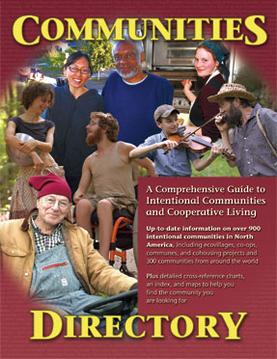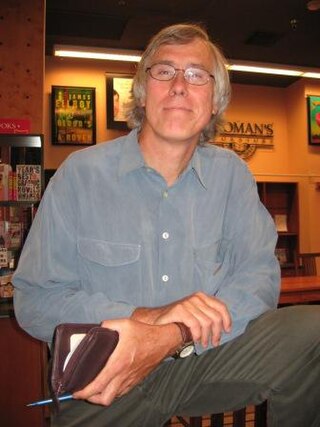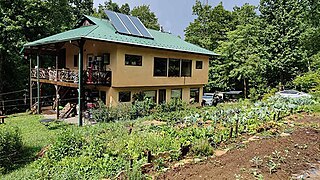
An ecovillage is a traditional or intentional community that aims to become more socially, culturally, economically and/or environmentally sustainable. An ecovillage strives to have the least possible negative impact on the natural environment through the intentional physical design and behavioural choices of its inhabitants. It is consciously designed through locally owned, participatory processes to regenerate and restore its social and natural environments. Most range from a population of 50 to 250 individuals, although some are smaller, and traditional ecovillages are often much larger. Larger ecovillages often exist as networks of smaller sub-communities. Some ecovillages have grown through like-minded individuals, families, or other small groups—who are not members, at least at the outset—settling on the ecovillage's periphery and participating de facto in the community. There are currently more than 10,000 ecovillages around the world.

Cohousing is an intentional, self-governing, cooperative community where residents live in private homes often clustered around shared space. The term originated in Denmark in the late 1960s. Families live in attached or single-family homes with traditional amenities, usually including a private kitchenette. As part of the communal orientation, shared spaces typically feature a common house, which may include a large kitchen and dining area, laundry, and recreational spaces. Walkways, open space, parking, playgrounds and gardens are common examples of shared outdoor spaces designed to promote social interactions. Neighbors also often share resources like tools, babysitting and creative skills.

Twin Oaks Community is an ecovillage and intentional community of about one hundred people living on 450 acres (1.8 km2) in Louisa County, Virginia. It is a member of the Federation of Egalitarian Communities. Founded in 1967, it is one of the longest-enduring and largest secular intentional communities in North America. The community's core values are cooperation, egalitarianism, nonviolence, sustainability, and income sharing. About 100 adults and 17 children live in the community.

An intentional community is a voluntary residential community designed to foster a high degree of social cohesion and teamwork. Members typically unite around shared values, beliefs, or a common vision, which may be political, religious, spiritual, or simply focused on the practical benefits of cooperation and mutual support. While some groups emphasise shared ideologies, others are centred on enhancing social connections, sharing resources, and creating meaningful relationships.
A charrette, often Anglicized to charette or charet and sometimes called a design charrette, is an intense period of design or planning activity.

Sunward Cohousing is an intentional community located in Ann Arbor, Michigan, United States. Sunward's founders were pioneers in bringing the cohousing model to Michigan.

Miccosukee is a small unincorporated community and census-designated place (CDP) in northeastern Leon County, Florida, United States. The population was 383 at the 2020 census. It is part of the Tallahassee, Florida Metropolitan Statistical Area. It is located at the junction of County Road 59 and County Road 151. Miccosukee was a major center of the Miccosukee tribe, one of the tribes of the developing Seminole nation, during the 18th century.

Welaunee Plantation was a large quail hunting plantation located in central Leon County, Florida, United States established by Udo M. Fleischmann.

Yarrow is a small community located 90 kilometres east of Vancouver within the City of Chilliwack in British Columbia, Canada. It is in the Fraser Valley at the foot of Vedder Mountain. The village was first settled by Mennonites in the late 1920s, following the draining of Sumas Lake and the reclamation of the former lake bed for agriculture.

The Communities Directory, A Comprehensive Guide to Intentional Community provides listing of intentional communities primarily from North America but also from around the world. The Communities Directory has both an online and a print edition, which is published based on data from the website.
Development-supported agriculture is a nascent movement in real estate development that preserves and invests in agricultural land use. As farmland is lost due to the challenging economics of farming and the pressures of the real estate industry, DSA attempts to reconcile the need for development with the need to preserve agricultural land. The overall goal of DSA is to incubate small-scale organic farms that co-exist with residential land development, providing benefits to farmers, residents, the local community, and the environment.
Celo Community, Incorporated is a communal settlement in the Western mountains of North Carolina, United States, located in the South Toe River valley of Yancey County, in the South Toe Township between the unincorporated areas of Celo and Hamrick. It was founded in 1937 by Arthur Ernest Morgan. Celo is a land trust with its own rules of taxation and land tenure that runs its internal government by consensus. The community does not require its members to accept any religion or ideology, but is based on ideals of cooperation between residents and care for the natural environment. However, its membership is predominantly Quakers. Celo has 40 families living on its 1,200 acres (4.9 km2).

The Ravenna Kibbutz was a nondenominational Jewish intentional community from 2007–2012 located in the Ravenna neighborhood of Seattle. Its three rented houses and one apartment were home to 15 resident-organizers, who plan public programs such as Shabbat dinners and Jewish movie nights. The Kibbutz's ideology was not communistic; it was not a true commune but simply an example of cohousing. The Pacific Northwest contains many cohousing communities and a wide variety of Jewish organizations, but thus far the region has no other Jewish cohousing community.

Charles "Chuck" Durrett is an American architect and author based in Nevada City, California.
Muir Commons is a cohousing development located in Davis, California. Completed in 1991, Muir Commons was designed by Kathryn McCamant and Charles Durrett at McCamant & Durrett Architects and is known for being the first new-construction cohousing development in the United States. Opposed to many traditional neighborhoods, Muir Commons was created and maintained around the premise of fostering a sense of community between its residents by facilitating community-level functionality. While each family or individual lives in a privately owned residence, many other features of the community are shared, including a central communal building, an orchard, gardens, yards, workshops, and even the decision-making process.

The Yarrow Ecovillage is an intentional community in Yarrow, British Columbia, Canada. Yarrow is a settlement of 3,000 population within the municipal boundaries of Chilliwack, British Columbia. The Ecovillage is a member-designed community that aims to achieve a more socially, ecologically and economically sustainable way of life. The Ecovillage's master plan for the 10-hectare (25-acre) former dairy farm, foresaw three main legal entities: An 8-hectare (20-acre) organic farm, a 31-unit multigenerational cohousing community, and a mixed-use development with just under 2800 m2 of commercial space, a 17-unit senior cohousing community and a learning centre.
Edgewater Park is a small 60-acre (24 ha) waterside co-op community of 675 single-family homes in the Throggs Neck section of the Bronx, north of the Cross Bronx Expressway (I-95) near the Throgs Neck Bridge. Its beaches overlook Long Island Sound. Its sister communities are Silver Beach, south of the Cross Bronx Expressway, as well as Harding Park.

Earthaven is an ecovillage in Western North Carolina, about 50 minutes from Asheville.
Kathryn "Katie" McCamant is an American architect, developer and author based in Nevada City, California. She is known for her work introducing the concept of cohousing in the United States, including co-authoring two books which introduced cohousing to the English-speaking world. She has designed, developed and consulted on dozens of cohousing communities across the United States, Canada and elsewhere.













